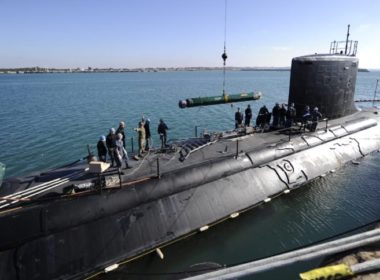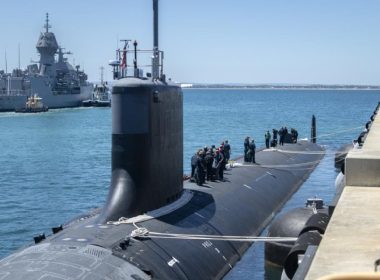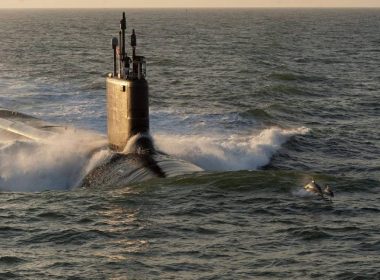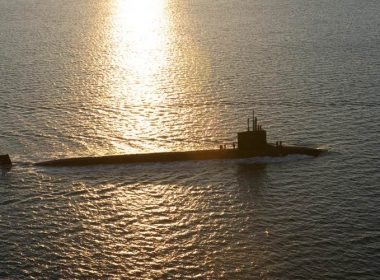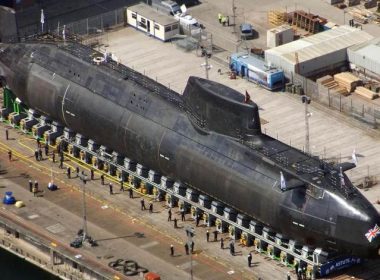OPINION | AUKUS: A solution to the risky UK gambit

Doubts about America’s capacity to build and then sell to Australia a series of Virginia-class nuclear-powered submarines (SSNs) under the AUKUS agreement have led Matthew Mai to conclude that, “It is unlikely the United States will be able to deliver SSNs within the timeline laid out”.
I agree there is a high probability that the US will not have any spare Virginia-class submarines to sell Australia. But it’s not just US shipyards struggling. The UK has its troubles too, suggesting Australia needs to re-think its so called “optimal pathway”.
The first problem is the intention to use a British design for the so-called SSN AUKUS, the submarine Australia proposes to introduce into navy service after it has inducted three to five Virginia-class boats.
The UK is struggling to sustain its submarine fleet. The Royal Navy’s force of four nuclear powered ballistic missile submarines (SSBNs) and six SSNs has fallen below critical mass. This force could normally be expected to deploy one SSBN and one to two SSNs. But times have not been good for the Royal Navy; one of the SSBNs has spent seven years in dock refuelling the reactor to rectify a defect. The remaining three have been hard pressed to maintain continuous deterrent patrols.
The Astute-class SSNs have been delivered late, over budget, and are proving difficult to maintain – there have been periods when none of the six has been at sea. The dry docks to repair them are having to be upgraded; currently no certified dry docks are available at the main repair site in Devonport Dockyard, with an SSBN and SSN waiting for a docking since earlier last year. Morale and, consequently, submarine personnel numbers have suffered. The sea-going experience necessary to develop the senior leadership and technical overseers has also suffered; the Royal Navy is advertising to fill a senior leadership position.
“The UK needs to prioritise the recovery of its own submarine service, but it must also sustain its existing submarine-based nuclear deterrent and introduce a new class of ballistic missile submarine.”
In terms of submarine numbers, manpower and shore infrastructure, recovery will not be simple or quick. A recent analysis of the UK’s planned defence equipment acquisition over the next decade identifies a worst-case 10 per cent shortfall in the budget, supporting the conclusion that it is “unaffordable, with over-spends on its nuclear programme now clearly responsible for the overall insolvency of the plan.”
The AUKUS program makes this a matter of particular concern for the US and Australia. The UK needs to prioritise the recovery of its own submarine service, but it must also sustain its existing submarine-based nuclear deterrent and introduce a new class of ballistic missile submarine. This is the UK’s priority, not SSN AUKUS. The risk of a delayed, over-cost, and inadequate SSN AUKUS design, requiring prolonged rectification to achieve operational capability, is much higher because of this combination of factors.
What of the US element of the “optimal pathway”? The plan envisages buying three to five Virginia-class submarines. Assuming the supply chains, workforce, and infrastructure are in place, five Virginias could be expected to provide one deployable SSN and occasionally a second. One SSN to defend Australia’s interest in the Pacific and Indian Ocean is a token force, and given the embryonic state of the capability, this estimate could prove optimistic. It is currently intended to construct a further three to five SSN AUKUS submarines to bring the total SSN force up to eight. That will provide two and occasionally a third SSN, again an inadequate number to cover the vast areas we need. Once again, my estimates are probably optimistic.
There is a significant risk that neither the Virginia-class nor AUKUS SSN will achieve critical mass or operational capability. A change of plan is needed to avoid this compounding situation.
“An evolved Virginia-class submarine will be less risky, cheaper, and importantly, quicker to reach operational capability.”
Using the American shipbuilder General Dynamics Electric Boat as the lead designer for an evolved Virginia-class design could solve these problems. I suggest Electric Boat be tasked with leading a design team (including BAE Systems and ASC, the UK and Australia’s submarine design houses, respectively) to produce an updated Virginia design available for construction in the UK, Australia, and the US. The new design should be simpler and quicker to build than the current Virginia-class, cheaper to own and operate, with a smaller crew. A more comprehensive list of the advantages is set out in my recent article in The Strategist.
The US Navy has built over 38 Virginia-class submarines and Electric Boat is well practised in building and updating them. Compared to the option for a UK-led design based on the unsatisfactory experience of the Astute-class, this option will be less risky, cheaper, and importantly, quicker to reach operational capability.
From an Australian perspective the advantages are significant:
- Reduced time to achieve an operational SSN capability, possibly avoiding the risks described by Matthew Mai of purchasing Virginia-class submarines from the US Navy
- Avoids the complications and expense of operating two classes of SSN designed to meet two different regulatory regimes
- Avoids the uncertainty and risks of introducing an unproven UK design
- Fully exploits the base and depot facilities established to support the US Navy Virginia-class submarines, which can be used to support this updated design, saving time, expenses, and personnel
- Provides a more appropriate design for Australia, as the RAN would operate one of many
- The savings, greater efficiency, and single-class solution offer a better chance to achieve a critical mass of Australian capability.
- Creates opportunities for Australian companies to provide support for a greater number of submarines, including in the UK and United States
All participants stand to benefit from this change. The design, construction, and through-life support efficiencies inherent in a single class of SSN operated by the three navies could considerably reduce the cost of ownership and deliver substantial resilience and interchangeability in times of emergency.
I agree with Matthew Mai; it is time to re-consider the plan to acquire SSNs, but not by acquiring B-21 bombers. The current SSN-AUKUS concept is one of hope over experience, ignores the realities of the US submarine building industry, and is at severe risk of becoming entangled in the difficulties being experienced in the UK’s Submarine Service, together with the limitations of its submarine building and maintenance infrastructure.


